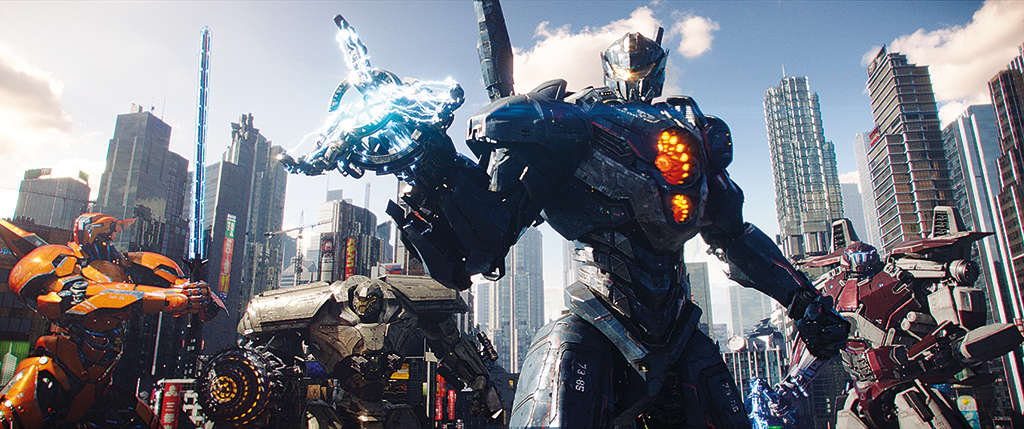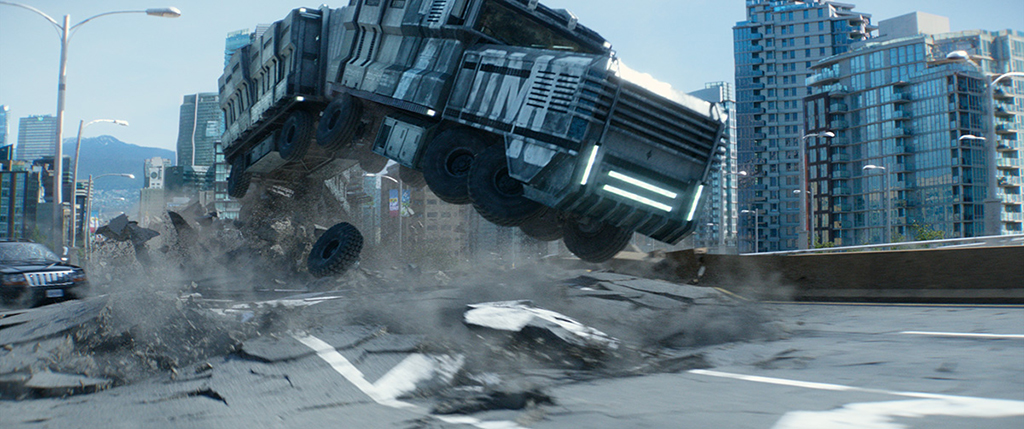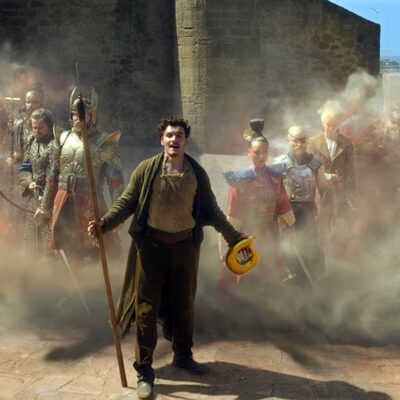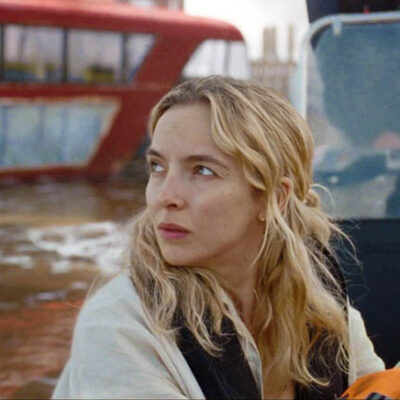
In The Meg, menacing giant sharks were realized by several VFX studios utilizing an array of flesh and water simulation tools. (Image © 2018 Warner Bros. Pictures)
CREATURE FEATURES
Of course, several of these comic book films could also be classified as ‘creature features,’ and there were many other movies released in 2018 that featured incredible classic creature work.
The Meg, for example, made use of not one, but two giant sharks. Visual Effects Supervisor Adrian De Wet says he had a number of favorite shots, including “the breach shot in the third act, where Jonas (Jason Statham) pushes the spike into the Meg’s eye while at the top of its arc, after it has jumped out of the ocean. My favorite could possibly be the whole boat capsizing sequence in the second act. It’s a real pivotal moment in the film and hopefully it’s entirely unexpected.”

Motion capture informed the main creature in Rampage, while other character work and building destruction made this film heavy on effects. (Image © 2018 Warner Bros. Pictures)
Rampage had three main digital characters and a whole lot of Chicago city destruction, as orchestrated by Weta Digital. “Rampage drew on our depth of experience making digital characters and also offered a juicy opportunity to destroy one of my favorite cities,” states Visual Effects Supervisor Erik Winquist. “The movie has a light-hearted tone and knows exactly what it is, but we took our role seriously in making sure that the heart and soul of the gorilla George came from actor Jason Liles.”
In Peter Rabbit, there’s far less destruction but still a significant number of meticulous CG performances from Animal Logic. “The biggest visual effects challenge on Peter Rabbit was the complex physical interactions between the actors and the CG characters, in particular the physical fight between Peter Rabbit and Mr. McGregor,” notes Visual Effects Supervisor Will Reichelt. “The success of these shots depended on a number of departments – from the stunt team choreographing the fight, to the SFX team providing specific physical interactions, to Domhnall Gleeson as Mr. McGregor himself.”
Christopher Robin is another film that matched CG characters to live-action actors, led by Framestore and Method Studios. “The tremendous challenge with Christopher Robin was to create characters capable of carrying the emotional heart of the movie,” says Visual Effects Supervisor Chris Lawrence. “They needed to be simple toys imbued with the magic of childhood imagination. We achieved this through craft as much as technology – nuanced animated performances, beautiful lighting and lensing, finished off with incredibly detailed simulations of fur and contact with plants, environments and of course: ‘Hunny!’”
Audiences got to witness a different kind of magic in Fantastic Beasts: The Crimes of Grindelwald, which made use of many CG creatures. Visual Effects Supervisor Christian Manz, who oversaw the VFX with Tim Burke, identified human-to-human and human-to-beast transformations as a major challenge. “We wanted both to feel physically plausible as much as possible, and to be viewed in close-up with no clever camera work to hide the joins.”

Pacific Rim Uprising’s animators followed a ‘heft and jank’ approach to the giant robots. (Image © 2018 Universal Pictures)
Robots might not normally be described as ‘creatures,’ but VFX studios still have to approach them that way. On Pacific Rim Uprising, Visual Effects Supervisor Peter Chiang identifies his giant robot challenge as “conveying scale and mass, while at the same time ensuring that the choreography of the battles remains exciting.”
Meanwhile, on Bumblebee, Visual Effects Supervisor Jason Smith says not only was believable CG character work important, it also had to involve an emotional connection between robot and girl. “Making the robot itself feel solidly rooted in the real world is a monumental task by itself. But the most important thing we tried to achieve in this film, by far our biggest hurdle, was making the audience really believe in that relationship so they could forget about VFX and just enjoy the story.”
With Jurassic World: Fallen Kingdom – a more traditional creature feature – Industrial Light & Magic enjoyed an unprecedented level of collaboration with Neal Scanlan’s creature FX team. “We wanted to engage the actors, DP, camera operators and director with the digital creatures in the film,” says Visual Effects Supervisor David Vickery, “and I really believe that the tangible energy and authenticity you can feel in the dinosaurs final on-screen performance would have suffered were it not for that collaboration.” Fallen Kingdom also exemplifies the important role of the previs teams in visual effects production. Proof, for example, worked on the previs for that film, and several others this past year. “What’s interesting about where we now fit into the ecosystem is that we fit in so many different ways,” suggests Proof President Ron Frankel. “On Jurassic and A Wrinkle in Time – those are films we were involved in from the very early days, almost from design and story development all the way through to postvis. We were a design resource and a story resource for the directors. Ideas were experimented with – some made it into the movie and some were left on the editing room floor – which is kind of the point.”

The Millennium Falcon travels through hyperspace in Solo: A Star Wars Story. VFX recreated well-known Star Wars vehicles and characters, sometimes using old-school techniques, as well as highly advanced means. (Image © 2018 Walt Disney Pictures)
WORLD BUILDING
Need a world for your film, with landscapes, buildings, vehicles and characters? Visual effects artists were behind so many of them in 2018. For Solo: A Star Wars Story, Visual Effects Supervisor Rob Bredow built a world that had to exist as if it had been filmed in the years leading up to the original Star Wars. “We leveraged some of the oldest visual effects techniques, such as front- and rear-screen projection and drove those immersive set-ups with the very latest technology,” says Bredow.
The latest technology was also on show in Ready Player One, where principal visual effects studios ILM and Digital Domain combined to reveal a world inside and outside the realms of virtual reality. “Realizing Steven Spielberg’s vision for Ready Player One was a massive creative and technical challenge – literally on a world-building scale – resulting in over 90 minutes of fully digital work being created for the film,” states Visual Effects Supervisor Roger Guyett. “Perhaps the most important challenge was faithfully maintaining each actor’s performance as they intercut between their live-action character and their digital avatar.”

For a moving city in Mortal Engines the VFX teams had to re-think how to create such vast assets for the film. (Image © 2018 Universal Pictures)
Much of the world also didn’t exist in Mortal Engines, which required Weta Digital to build massive cities that could move, a major challenge of scale, says Visual Effects Supervisor Ken McGaugh. “The creative side to this challenge was finding a balance between believable scale and exciting action, which were often at odds with each other. The technical challenge comes from the fact that we could not use our normal optimizations when rendering large-scale environments that move like a vehicle. We had to engineer a whole new hierarchical layout puppet system to handle animating the cities and a dynamic level-of-detail generator to handle rendering them.”
A Wrinkle in Time consisted of a multitude of fantastical locations, with Visual Effects Supervisor Rich McBride working closely with director Ava DuVernay to help realize them. “Ava really wanted to know all the different steps involved,” McBride said at a VES screening of the film. “So it was just a matter of collecting all of the different pieces that we go through, and it helped a lot to have a previs team in-house that she could work with, so she could just sit down at the computer and look at cameras, and see the virtual way of working.”

Miniatures, on-set practical effects, digital visual effects and archival restoration made up the VFX for First Man. (Image © 2018 Universal Pictures)
It might not have been fantastical, but the 1960s world of First Man still required a combination of effects artisans to build it. This included on-set gags, miniature effects, digital effects and even restored archival footage projected on LED panels to recreate, with absolute plausibility, launches and space mission scenes.
“With First Man being a period piece from the 1960s, anything that felt like heavy VFX would have completely taken you out of the story,” says Visual Effects Supervisor Paul Lambert. “The effects had to be subtle and shot in a particular way to make it feel like footage from the day. We used a diverse mixture of visual effects, special effects, archival footage and miniatures. We also shot full-scale models on 6-axis gimbals in front of a curved 60-foot diameter and 35-foot-tall LED screen. Using 90 minutes of content we created at DNEG, we were able to create a pseudo fully-three-dimensional world in-camera.”
DIGITAL HUMAN-LIKE PERFORMANCES
In past years, VFX-Oscar winning films such as The Curious Case of Benjamin Button, Avatar and Blade Runner 2049 have showcased the latest in CG human or human-like performances. Infinity War’s Thanos and the avatars of Ready Player One certainly fit into that category, as do a few other films from 2018.
In Alita: Battle Angel, Weta Digital made use of a motion-captured performance by Rosa Salazar to deliver its main character. “Through high-fidelity performance capture, and multi-camera facial acquisition, we were able to gather and recreate the subtle mannerisms that are recognizably Rosa,” explains Visual Effects Supervisor Eri Saindon. “By using Weta’s muscle and skinning systems, we were able to bring Alita to life as a CG character. Adding in lots of interaction between the Battle Angel and live-action characters is what really sets this movie apart from others.”
It might not seem at first like a candidate for human-like performance, but Welcome to Marwen definitely fits the bill. Here, Atomic Fiction incorporated Steve Carrell’s live-action likeness into his digital doll representation. “Robert Zemeckis insisted that the dolls be completely relatable as living, breathing characters,” says Visual Effects Supervisor Kevin Baillie. “He was adamant that their facial performances had to be flawlessly faithful to the actors’ since, in his words, ‘the face is the actor’s instrument, just like a violin is the musician’s.’”

In Mission: Impossible – Fallout, lead actor Tom Cruise performed as many stunts as possible, with VFX aiding and assisting to add in necessary elements. (Image © 2018 Paramount Pictures)
THE OUTSIDERS
Every year a film that might not normally be considered a major VFX contender pushes through. In 2015, one of those, Ex Machina, went on to win the VFX Oscar. There are several possible contenders from this past year.
With 2,000 VFX shots, Mission: Impossible – Fallout is light years from a small film maximizing VFX like Ex Machina. The VFX work is highly story-driven and integrated with significant practical and stunt effects. “On many films, the tendency is to shoot on a bluescreen and then have VFX do all the rest of the work,” outlines Visual Effects Supervisor Jody Johnson. “But on a Mission film, it’s more traditional filmmaking. The best bit is getting those puzzles and working them out. How are we going to shoot up the pieces and put them all together?”
That sentiment is backed up by Special Effects Supervisor Neil Corbould. “It was great working with Tom Cruise on a Mission: Impossible movie as he has a great appreciation for practical special effects and doing things for real. We really pushed the boundaries on Fallout, from a rotating sinking prison van rig, to a helicopter crash impact effect that Tom wanted to be very much involved in. My role as a special effects supervisor was to produce amazing special effects for Tom to be in and to keep him safe at all times.”
A Quiet Place saw Industrial Light & Magic incorporate a CG character sparingly, but effectively, into the horror film. “Director John Krasinski referred to Alien and Jaws as movie styles that he wanted to emulate,” discusses Visual Effects Supervisor Scott Farrar. “I totally agreed, it’s far more effective to show as little as possible for most of the movie, increasing the tension by slowly revealing the look of the creature near the end.”

Annihilation’s effects ranged from the petro-chemical-looking Shimmer, to CG creatures and other strange occurrences. (Image © 2018 Paramount Pictures)
The effects are equally as eerie in Annihilation, and also had to evolve over production, as Visual Effects Supervisor Andrew Whitehurst explains. “Sometimes we threw away months of work when we realized that, as the film had evolved, our original ideas were no longer right for the film. Every frame of every shot had to be considered in this light for the film to weave its spell on the audience. The Annihilation VFX team understood this and maintained their enthusiasm, dedication, and creativity right until the very end of the show, and it’s their hard work that we see on screen and gives me such pleasure to look at.”
Other films that might be considered outsiders: The Nutcracker and the Four Realms, for another round of substantial world building; Skyscraper, a film that not only makes a building its central character but also has a wealth of stunts and fiery scenes; and Mary Poppins Returns, which has the unique appeal of combining 2D animation into the final shots.





















